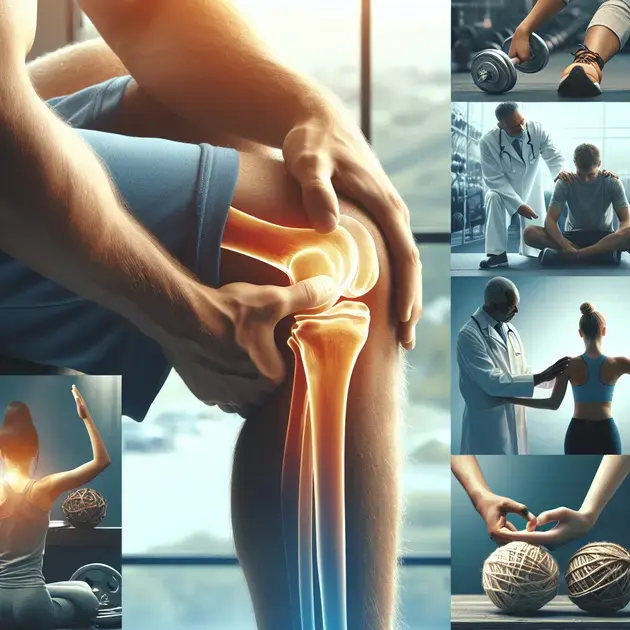Have you ever found yourself asking, “Why is my knee sore?” If so, you’re not alone. Knee pain is a common issue that many people experience at some point in their lives. Understanding the root causes of knee discomfort is essential to finding the right remedies and getting back to pain-free living.
From overuse injuries to underlying medical conditions, there are various reasons why your knee may be hurting. By delving into the common causes of knee pain and exploring effective remedies, you can take proactive steps towards improving your knee health and overall well-being.

Common Causes of Knee Pain
When it comes to knee pain, there are various factors that can be contributing to the discomfort. Understanding the common causes can help in effectively addressing and managing the pain. Here are some of the most prevalent reasons for knee pain:
1. Overuse and Injury
One common cause of knee pain is overuse or injuries resulting from activities such as running, jumping, or repetitive stress on the knees. To prevent and alleviate this type of pain, it is essential to practice proper warm-up and cool-down techniques before and after exercise. Utilize apps like MyFitnessPal to track your workouts and ensure you are not overexerting your knees.
2. Arthritis
Arthritis, including osteoarthritis and rheumatoid arthritis, is another leading cause of knee pain. Managing arthritis-related knee pain involves maintaining a healthy weight, staying active with low-impact exercises, and using assistive devices when necessary. Apps like Arthritis Health can provide valuable information on exercises and lifestyle changes to manage arthritis pain.
3. Excess Weight
Being overweight or obese puts extra stress on the knees, leading to pain and discomfort. Losing weight through a combination of a balanced diet and regular exercise can significantly reduce knee pain associated with excess weight. Using apps like MyPlate can help in tracking your food intake and staying on target with weight loss goals.
4. Muscle Imbalances
Imbalances in muscle strength or flexibility around the knee joint can cause misalignment and pain. To address muscle imbalances, incorporate exercises that target the quadriceps, hamstrings, and calf muscles. Apps like Fitbod can create personalized workout plans focusing on muscle balance to alleviate knee pain.
5. Lack of Flexibility
Poor flexibility in the muscles and tendons around the knee can lead to increased stress on the joint, resulting in pain. Implementing a stretching routine that targets the quadriceps, hamstrings, and IT band can improve flexibility and reduce knee pain. Apps like StretchIt provide guided stretching routines for enhanced flexibility.
Effective Remedies for Knee Discomfort
Knee discomfort can be a hindrance to daily activities, but there are effective remedies that can help alleviate pain and improve mobility. By incorporating these remedies into your routine, you can experience relief from knee discomfort. Here are some proven remedies:
1. RICE Method
The RICE method (Rest, Ice, Compression, Elevation) is a classic remedy for reducing knee inflammation and pain. Utilize an app like First Aid by American Red Cross to learn proper techniques for applying ice and compression to your knee for relief.
2. Topical Analgesics
Topical analgesic creams or patches can provide localized pain relief for sore knees. Look for products containing ingredients like menthol or capsaicin for soothing effects. Apps like GoodRx can help in locating and comparing different topical analgesic products available in pharmacies near you.
3. Physical Therapy
Engaging in physical therapy sessions can help strengthen the muscles around the knee joint and improve flexibility and range of motion. Apps like BetterPT can connect you with qualified physical therapists in your area for personalized treatment plans to address knee discomfort.
4. Acupuncture
Acupuncture has been known to provide relief for knee pain by stimulating specific points in the body to reduce inflammation and promote healing. Consider using apps like Zeel to find licensed acupuncturists who can perform sessions focused on alleviating knee discomfort.
5. Nutritional Supplements
Certain nutritional supplements like glucosamine, chondroitin, and turmeric can aid in reducing knee pain and improving joint health. Consult with healthcare professionals or use apps like Care/of to discover high-quality supplements tailored to support knee health.
Improving Knee Health: Proactive Steps to Take
Preventive measures play a crucial role in maintaining optimal knee health and reducing the risk of pain and injuries. By taking proactive steps towards improving knee health, you can enhance your overall well-being and mobility. Here are some proactive measures to consider:
1. Low-Impact Exercises
Engage in low-impact exercises such as swimming, cycling, or yoga to strengthen the muscles around the knee joint without causing excessive strain. Apps like Peloton offer guided cycling classes while apps like Asana Rebel provide yoga routines tailored for knee health.
2. Proper Footwear
Wearing supportive and well-fitted footwear is essential for maintaining proper alignment and reducing strain on the knees. Use apps like Adidas Running to find the right running shoes or apps like Zappos for a wide selection of footwear suitable for your knee health needs.
3. Healthy Eating Habits
A balanced diet rich in nutrients like vitamins C and D, calcium, and omega-3 fatty acids can promote joint health and reduce inflammation in the knees. Apps like MyFitnessPal can help track your nutrient intake and ensure you are eating a well-rounded diet for optimal knee health.
4. Regular Check-ups
Schedule regular check-ups with healthcare providers, including orthopedic specialists or physical therapists, to monitor your knee health and address any concerns promptly. Use apps like Zocdoc to easily book appointments with healthcare professionals who specialize in knee care.
5. Mindful Movement
Practicing mindfulness techniques such as tai chi or meditation can improve body awareness and promote proper alignment and movement patterns to protect the knees. Apps like Headspace offer guided meditation sessions for mindfulness and stress reduction, benefiting overall knee health.

Understanding the Anatomy of Knee Pain
Understanding the anatomy of knee pain is crucial for effectively managing and treating this common issue. The knee is a complex joint that consists of bones, ligaments, tendons, and cartilage. When any of these components are damaged or inflamed, it can result in pain and discomfort. The most common causes of knee pain include osteoarthritis, ligament injuries, tendonitis, and meniscus tears.
One lesser-known factor that can contribute to knee pain is poor foot mechanics. Issues such as flat feet or overpronation can lead to misalignment in the lower body, putting extra strain on the knees. Additionally, weak muscles surrounding the knee joint can also lead to instability and pain.
To effectively address knee pain, it is important to consult with a healthcare professional for an accurate diagnosis. Physical therapy, medication, injections, and in severe cases, surgery, may be recommended for treatment. Understanding the specific cause of your knee pain is key to developing an appropriate treatment plan.
When dealing with knee pain, it is essential to avoid activities that exacerbate the symptoms. High-impact sports, prolonged standing, and repetitive bending can all put additional stress on the knees, leading to increased pain and inflammation. By understanding the anatomy of the knee and the factors that contribute to pain, individuals can take proactive steps towards managing and alleviating their symptoms.
Common Activities that Aggravate Knee Soreness
Identifying common activities that aggravate knee soreness is essential for preventing further discomfort and injury. One activity that is known to worsen knee pain is running on hard surfaces without proper cushioning. The repetitive impact from running can put strain on the knees, leading to soreness and potential injuries.
Another common culprit for aggravating knee soreness is improper form during exercises such as squats and lunges. Incorrect technique can place unnecessary stress on the knee joint, causing pain and inflammation over time. It is crucial to maintain proper alignment and use appropriate modifications to prevent aggravating knee soreness.
Participating in activities that involve sudden stops and changes in direction, such as basketball or tennis, can also contribute to knee soreness. The quick and jolting movements can strain the ligaments and cartilage in the knee, resulting in discomfort and potential injuries.
To alleviate knee soreness, it is recommended to incorporate low-impact exercises, such as swimming or cycling, into your routine. These activities offer a cardiovascular workout without putting excessive stress on the knees. Additionally, practicing proper warm-up and cool-down routines, as well as using supportive footwear, can help prevent aggravating knee soreness during physical activities.
Conclusion
Understanding the anatomy of knee pain is essential for effective management and treatment of this common issue. The knee, being a complex joint composed of various components like bones, ligaments, tendons, and cartilage, can lead to pain and discomfort if any of these are damaged or inflamed. Common causes of knee pain include osteoarthritis, ligament injuries, tendonitis, and meniscus tears.
Poor foot mechanics, such as flat feet or overpronation, can also contribute to knee pain by causing misalignment in the lower body and additional strain on the knees. Weak muscles around the knee joint can result in instability and pain as well. Seeking professional help for an accurate diagnosis is crucial, as treatments like physical therapy, medication, injections, or surgery may be necessary based on the specific cause of the knee pain.
To manage knee pain effectively, it’s important to avoid activities that worsen the symptoms, such as high-impact sports, prolonged standing, and repetitive bending. By understanding the anatomy of the knee and the factors that can lead to pain, individuals can take proactive steps in alleviating and managing their symptoms. Incorporating low-impact exercises like swimming or cycling, maintaining proper warm-up and cool-down routines, and using supportive footwear can all aid in preventing further aggravation of knee soreness during physical activities.